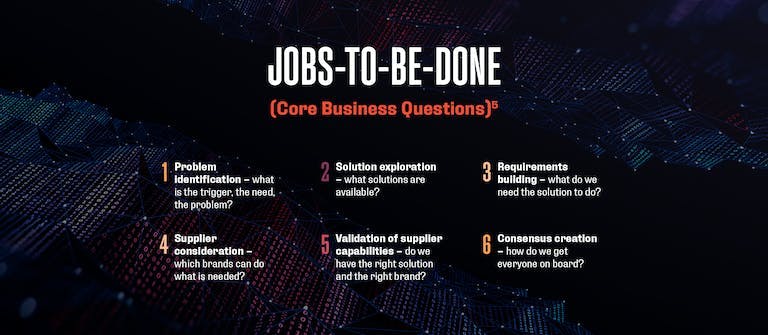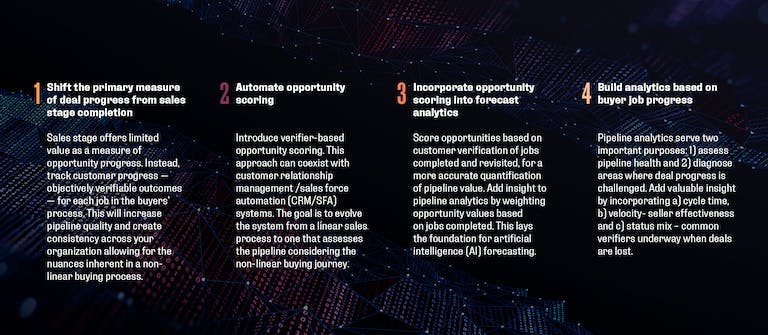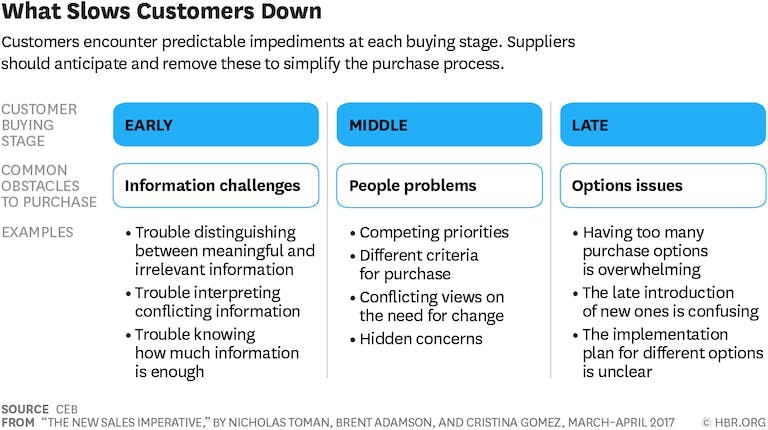Following up from our introductory blog, 3 Practices To Rev Your B2B Growth Engine, this is our second of 3 drill down posts focused on Connecting the Buyer Journey to the Sales Process. In the coming weeks, we’ll also address optimizing digital tools to foster brand engagement.

In our last blog, Mapping the B2B Buyer Journey, we revealed how increasingly non-linear the buyers’ journey has become involving multiple touchpoints and channels to reach a purchase decision. We also acknowledged the swift movement to remote and digital sales, driven by the pandemic.
Couple those shifts with an ever-growing list of stakeholders (6-7 on average) ¹, actively involved in B2B purchases. There is no question – the B2B sales process has faced massive disruption in a very short period. The ability of most brands to successfully navigate each of those changes in a way that does not compromise their growth, is modest at best.
The questions you should be asking and working to effectively answer include:
1. How has your customers’ buying process evolved over the last 6 months?
2. How effective has your reaction to this change been to your growth?
3. What is the next stage of the digital sales evolution?
KNOW THY CUSTOMER:
EXAMINING CHANGES IN THE BUYING PROCESS
Let’s revisit the facts to understand how quickly digital sales and marketing have become the norm in the B2B environment.
In less than 7 months²:
96%+ of B2B organizations have changed their go-to-market model, necessitated by COVID-19
Digital and remote channels are now being used on a much more regular basis by B2B buyers:
70%+ to identify and evaluate new suppliers
80%+ to order and re-order
Day-by-day we are quickly seeing these situations play out in our own environments leading to the realization that the buyer is in the driver’s seat – navigating their course, selecting their pathways, modulating their speed and moving deftly across channels. The average B2B customer uses six different interaction channels throughout the buying process. 3 Comfort with the omnichannel environment is ever increasing as Forrester reports that B2B buyers are actively shifting their transaction volume from single-channel offline environments to “omnichannel” and online-only environments.
75% of buyers and sellers now prefer the digital self-serve and remote human engagement model over face-to-face interactions because these interactions have made it easier to get information, place orders, and arrange service; improving the customer experience with speed and convenience!
At the same time, benefits to Sellers are becoming more tangible:
70% of B2B decision-makers say they are open to making new, fully self-serve or remote purchases in excess of $50K
27% would spend more than $500K.
No doubt there is much work to be done to effectively promote and distinguish your B2B brand in the ‘always on’ omnichannel environment. No matter the channel or the forms of engagement, the goal should be to guide buyers through their journey – informing, educating, simplifying and anticipating their next steps.
Pinpointing the bumps in the road and proactively addressing them…
If you are like most B2B organizations, you are actively learning as you go. By building a working knowledge of the Jobs-to-be-Done along the buyers’ journey, you raise your awareness of what is needed, when it is needed, and the many ways customers may want to access it.
Harvard Business Review has identified the common obstacles that arise at different stages of the buying process, revealing the challenges buyers face.4
The most successful brands embrace these obstacles by learning about needs and expectations, piloting concepts and methods, and continuously pivoting to improve brand engagement and maximize brand selection.
Let’s dissect each of these major stages to reveal the opportunities that exist. We’ll start by establishing a few ground rules:
- Our environment is largely digital with remote human interaction
- The Jobs-to-be-Done tasks serve as our foundation
- The buyer needs to feel enabled and confident to identify and evaluate brands in order to make smart purchases
EARLY BUYING STAGE (Information Challenges)
Goals: provide education and expertise, offering a meaningful, personal progression through your products, services, and solutions in support of the buyers’ questions and tasks.
Questions to answer: 1. Problem identification and 2. Solution exploration
Best practices to consider: the customer needs to see their situation in your offers. You understand their needs and have the experience and expertise to address their challenges and opportunities. You step them through your process to address the situation – explore the options available to them, the pros and cons of different approaches, ways to determine the right path for their needs.

MIDDLE BUYING STAGE (People Problems)
Goals: relate to stakeholder personas through relevant value drivers to grow brand familiarity, relevance and fit for decision-makers and influencers.
Questions to answer: 3. Requirements building and 4. Supplier consideration
Best practices to consider: the challenge is understanding the various stakeholders, their personas and value drivers. This can be accomplished by helping the buyer formulate their requirements, acknowledging the differences in stakeholder needs, and helping them build the case that your brand is best suited to fulfil the all of the needs of decision-makers and influencers (likely across an array of functions).
LATE BUYING STAGE (Options Issues)
Goals: provide comparative tools to assess options relative to needs and applying real-life examples of how other businesses with similar needs have succeeded based on the decisions made.
Questions to answer: 5. Validation of supplier capabilities and 6. Consensus creation
Best practices to consider: options come in many different shapes and sizes. They can be brand options, solution options, price options, timing options, etc. The goal is to offer the tools and content that will guide the buyer to the right selection. Not unlike the early buying stage, the buyer needs help, guidance and anticipation. In addition to tools and content, proof points of success – case studies, testimonials, outcomes, and ROI – play a major role in convincing the buyer your band has lived their situation before and successfully navigated it.
A final consideration. We must not forget that questions 5 and 6 in the Jobs-to-be-Done framework may very well need attention in the Early and Middle Buying Stages. These are the tasks that most buyers are actively revisiting time and again as they progress through their journey.
NEW JOURNEY, NEW METRICS: MEASURE EFFECTIVENESS OF THE SALES PROCESS
As sales engagement move to a more digital world, the measurement of the sales process has become increasingly complex – often lacking some of the nuances that have become the norm.
Currently, sellers determine a deal’s probability to close, close date and work remaining, primarily by the internal sales stage. Gartner believes this approach is flawed leaving sellers unable to proactively identify stalled deals and prescribe helpful solutions to rescue those deals in the moment. If we agree the buyers’ journey has changed, why not change the sales metrics to match?
To overcome the disconnect, Gartner recommends 4 key steps for sales leaders. 6

As we discussed in our last blog, no matter where you may be on your digital sales journey, there is always opportunity to optimize. But to gauge progress you must monitor change – both change in processes as well as the evolution of behaviors.
Here are some of the essential questions you will want to answer about your sales process metrics:
- Accuracy of forecasting – How well are you capturing deal progress and status? What tasks in the new non-linear buyer journey have the biggest impact on forecast accuracy?
- Predictable sales cycles – How are your sales cycles evolving? Do you know what and who might be impacting your sales cycles?
- Timely Intervention – How do you proactively diagnose when and what types of interventions are needed to revive stalled deals? What are the best tools and channels for interventions?
- Transparency of deal loss – What are the common tasks when deals are lost? Are those tasks partially or fully completed?
FOCUS ON THE FUTURE: BY STAYING ONE STEP AHEAD OF THE DIGITAL SALES EVOLUTION
It has become very evident over the past few months that technology in the B2B sales process is not a nice to have, it is a MUST have to build leads and continue to target and serve clients. However, accepting technology as a need is the easy part. The real work comes in building out the technological ecosystem by deciphering what to use when to use it along with the interoperability of the systems to talk to one another.
In our next blog we will dive deeper into technologies that can be leveraged and have enhanced the sales journey throughout the entire process – from initial engagement to post sale communications.
WHERE BIG VILLAGE COMES IN
At Big Village we work with B2B clients day in and day out to understand their buyers and how best to engage with them, create solutions and develop marketing programs that are highly visible and resonate with target segments.
Our tenants for connecting the sales process to the buyer journey:
Sales Success Begins and Ends with a Strategy: Strategy defines your objectives and establishes your goals. It sets the course for your investments and initiatives. Learning from the best – leveraging processes and practices that can be emulated in your environment while also avoiding the pitfalls and the mistakes, is what leaders do.
Understanding Your Buyers’ Journey Impacts Sales Success: As your buyers navigate changes in their business environments, their behaviors and processes evolve. Your marketing and sales efforts depend on a clear understanding of the buyer – their needs and expectations and their journey through brand identification, evaluation and selection. These fundamentals must be kept up to date to compete effectively.
Drive Sales ROI with Modernized Sales Enablement: Digital transformation has not only changed the Buyers’ world it has changed the Sellers’ world. As face-to-face interactions move to virtual engagement, Sellers need modernized enablement training, intelligence and tools to stay current. Up-to-date trends and patterns in the market and with the competition, coupled with detailed understanding of the buyers’ journey are essential. This intelligence is critical for battlecards and talk tracks, new channels to be explored and alternative forms of media to inform, educate and guide buyers.
What’s next?
Stay tuned for our next blog in this four-part series, Optimizing Digital Tools to Foster Brand Engagement, where we will dive deeper into digital channels, tools and how best to leverage them.
Big Village: B2B is in our DNA. We have spent the last 50+ years helping businesses identify the most effective ways to create sustainable growth. In today’s environment, your ability to tap into your markets, competitors, prospects and customers and to effectively synthesize the learning for action, is essential. We have the tools, techniques and the expertise to help you succeed!
Written by Linda Shea, EVP Business Advisory Services, Big Village Insights.
1 “The New Sales Imperative.” Harvard Business Review. April 2017.
2 “These Eight Charts Show How COVID-19 has changed B2B Sales Forever.” McKinsey & Company. October 2020
3 “Top B2B eCommerce Trends for 2020.” Medium. February 2020.
4 “The New Sales Imperative.” Harvard Business Review. April 2017.
5 “CSO Update – The new B2B buying journey and its implications for sales” Gartner. 2019.
6 “Sync Sales Pipeline Management to the B2B Buying Journey.” Gartner. Nov. 2019


